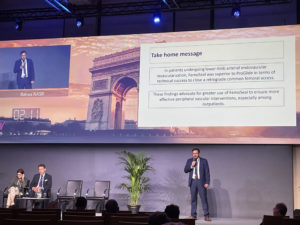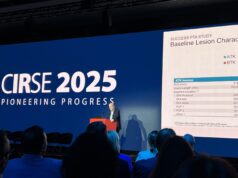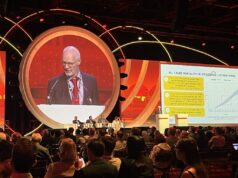
Results of the randomised, prospective, multicentre STEP trial show that the FemoSeal vascular closure system (Terumo) is superior to the Perclose ProGlide suture-mediated closure system (Abbott) in peripheral arterial disease (PAD) patients in terms of technical success using a retrograde femoral puncture. Bahaa Nasr (Brest University Hospital, Best, France) presented the late-breaking data at Paris Vascular Insights (PVI) 2021 (21–23 October, Paris, France), concluding that FemoSeal should be used in PAD patients undergoing lower limb arterial endovascular treatment, especially if they are discharged on the same day as their surgery.
According to Nasr, many studies have compared vascular closure devices (VCDs) for the coronary arteries, while none have compared them for PAD. “We all know that the efficacy of a VCD is different for PAD patients because of the plaque nature in the common femoral artery,” he remarked.
In order to assess this gap in the literature, Nasr and colleagues initiated the STEP trial. “The aim of the study was to perform a direct, head-to-head comparison between ProGlide and FemoSeal,” he relayed, explaining that the FemoSeal is a double polymer resorbable disc, while the ProGlide involves a direct suture in the artery. He noted that the primary endpoint was VCD technical success, assessed five hours post-procedure, and defined as either haemostasis without the need for either an additional VCD or manual compression, or a drop in haemoglobin.
Patients were included in the study if they had received endovascular treatment for PAD with the use of 5–7Fr sheath, Nasr informed the PVI audience. He added that patients who had undergone previous ipsilateral open repair of the common femoral artery, previous stenting at the puncture site, or had either radial, brachial or antegrade femoral punctures were excluded.
Nasr relayed that all patients were treated with a duplex scan-guided, retrograde common femoral artery puncture. He detailed that the resumption of ambulation was assessed five hours after the procedure and that all the investigators were certified and trained for both VCDs.
A total of 230 patients were randomised, with 109 patients undergoing treatment with the assigned device in each group. According to Nasr, the baseline clinical and demographic characteristics were well balanced between the two groups. The presenter highlighted the fact that most of the patients included in the study had intermittent claudication—86% in the FemoSeal group and 85% in the ProGlide group.
The majority of the procedures were performed under local anaesthesia and the most commonly-used sheath was 6Fr diameter, Nasr told PVI delegates. He added that there were no differences in intraoperative antithrombotic regimens, and in fact the only difference between the two groups was the need for a compression dressing, which was higher in the ProGlide group.
Nasr reported that the intention-to-treat analysis showed an 80% technical success rate in the FemoSeal group, which was higher than the 50% rate achieved in the ProGlide group. The difference in technical success could be explained by the need for additional VCDs and a greater need for manual compression in the ProGlide group, the speaker explained. He elaborated: “In the ProGlide group, when taking into account the use of a second VCD, the technical success rate was 90%.”
Postoperative bed rest and hospital stays were similar in both groups, the presenter communicated. The rate of minor access-related complications were higher in the ProGlide group, he added, noting finally that the additional cost per patient valued between 23 and 30% in favour of FemoSeal.
Moderator Marianne Brodmann (Medical University of Graz, Graz, Austria) was “really impressed” that Nasr and colleagues had found the device to be more cost effective, adding a more general comment that it is a “very good idea” to compare two different VCDs for peripheral interventions. In this vein, Brodmann was keen to know if the speaker thought we should conduct more studies and compare more devices in order to end up with one device—“the most cost efficient, effective and safe one”.
“I think we have to talk about other devices,” Nasr replied, noting also that investigators must compare devices with magnet compression and low-profile sheaths.
Speaking from the audience, Eric Ducasse (Bordeaux University Hospital, Bordeaux, France) agreed with Brodmann that it is important to prove a device’s cost effectiveness, but stressed that “we need to go deeper into the comparison”. Data concerning other factors—such as the distance between the artery and the skin, previous fibrotic intervention, the amount of calcification, the position of the plaque, and the wideness of the artery that is punctured—is required, he stressed, in order to “really compare objectively” the different systems.













